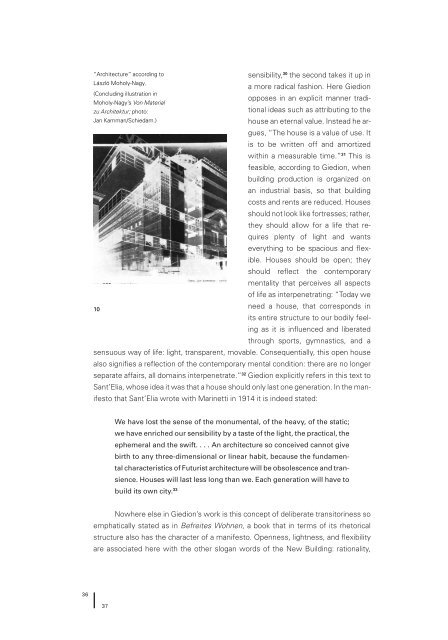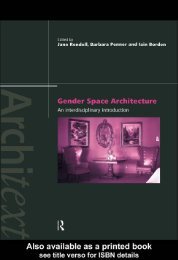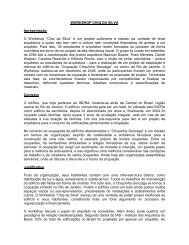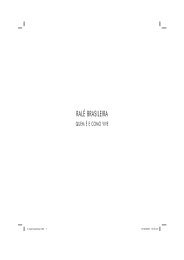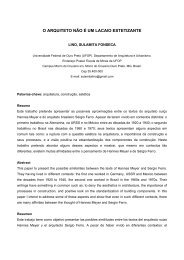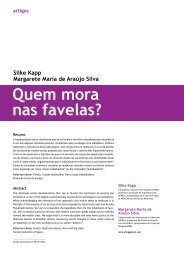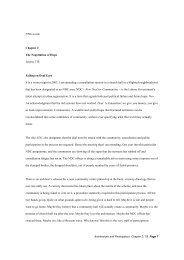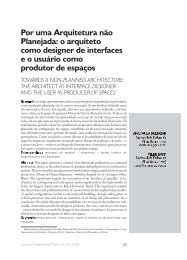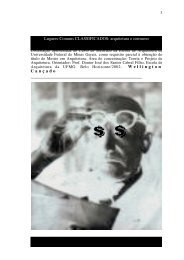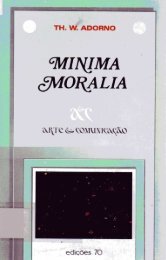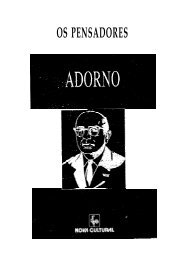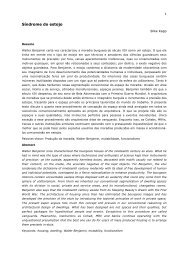Architecture and Modernity : A Critique
Architecture and Modernity : A Critique
Architecture and Modernity : A Critique
You also want an ePaper? Increase the reach of your titles
YUMPU automatically turns print PDFs into web optimized ePapers that Google loves.
36<br />
sensibility, 30 the second takes it up in<br />
a more radical fashion. Here Giedion<br />
opposes in an explicit manner traditional<br />
ideas such as attributing to the<br />
house an eternal value. Instead he argues,<br />
“The house is a value of use. It<br />
is to be written off <strong>and</strong> amortized<br />
within a measurable time.” 31 This is<br />
feasible, according to Giedion, when<br />
building production is organized on<br />
an industrial basis, so that building<br />
costs <strong>and</strong> rents are reduced. Houses<br />
should not look like fortresses; rather,<br />
they should allow for a life that requires<br />
plenty of light <strong>and</strong> wants<br />
everything to be spacious <strong>and</strong> flexible.<br />
Houses should be open; they<br />
should reflect the contemporary<br />
mentality that perceives all aspects<br />
of life as interpenetrating: “Today we<br />
need a house, that corresponds in<br />
its entire structure to our bodily feeling<br />
as it is influenced <strong>and</strong> liberated<br />
through sports, gymnastics, <strong>and</strong> a<br />
sensuous way of life: light, transparent, movable. Consequentially, this open house<br />
also signifies a reflection of the contemporary mental condition: there are no longer<br />
separate affairs, all domains interpenetrate.” 32 “<strong>Architecture</strong>” according to<br />
László Moholy-Nagy.<br />
(Concluding illustration in<br />
Moholy-Nagy’s Von Material<br />
zu Architektur; photo:<br />
Jan Kamman/Schiedam.)<br />
10<br />
Giedion explicitly refers in this text to<br />
Sant’Elia, whose idea it was that a house should only last one generation. In the manifesto<br />
that Sant’Elia wrote with Marinetti in 1914 it is indeed stated:<br />
37<br />
We have lost the sense of the monumental, of the heavy, of the static;<br />
we have enriched our sensibility by a taste of the light, the practical, the<br />
ephemeral <strong>and</strong> the swift. ... An architecture so conceived cannot give<br />
birth to any three-dimensional or linear habit, because the fundamental<br />
characteristics of Futurist architecture will be obsolescence <strong>and</strong> transience.<br />
Houses will last less long than we. Each generation will have to<br />
build its own city. 33<br />
Nowhere else in Giedion’s work is this concept of deliberate transitoriness so<br />
emphatically stated as in Befreites Wohnen, a book that in terms of its rhetorical<br />
structure also has the character of a manifesto. Openness, lightness, <strong>and</strong> flexibility<br />
are associated here with the other slogan words of the New Building: rationality,


